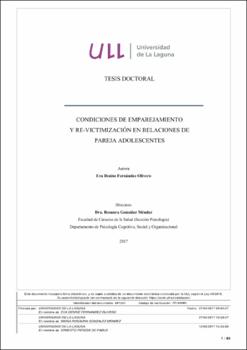Condiciones de emparejamiento y re-victimización en relaciones de pareja adolescentes
Fecha
2017Resumen
Uno de los problemas que afecta a las relaciones de pareja adolescentes es la aparición de distintas formas de abuso. En algunos casos, estas relaciones siguen un patrón persistente de violencia o victimización. El objetivo de esta tesis ha sido estudiar las condiciones del entorno relacional que facilitan la victimización y la re-victimización. Para ello, se llevaron a cabo dos estudios. En el primero, exploramos las condiciones del entorno relacional que restringen las oportunidades de emparejamiento (características del grupo de iguales, forma de inicio de la relación, percepción de riesgo del barrio), así como la relación entre dichas condiciones y la implicación en relaciones violentas (violencia y victimización). El segundo recoge los datos de dos cursos consecutivos. En la primera fase, se analizó la relación entre las condiciones de emparejamiento, las estrategias de supervisión de las familias y la violencia/victimización en las relaciones adolescentes. En la segunda, comparamos las condiciones de los casos donde hubo re-victimización (nivel alto de victimización en ambas fases) con el resto de casos. Los resultados confirmaron que la victimización es más frecuente entre quienes se implicaban en actividades de riesgo, sufren presiones para iniciar sus relaciones, y tienen una supervisión menos efectiva. En el caso de las chicas, el grupo de iguales aparece como principal contexto de riesgo. Se confirma que un entorno de riesgo estable hace más probable que la victimización se mantenga en el tiempo. Las chicas re-victimizadas presentaban más riesgo en el primer año (amigos conflictivos, baja supervisión y consumo de alcohol) y mantenían dicho riesgo durante el segundo año. El consumo de alcohol también tiene un peso predictivo importante en la victimización y re-victimización. Los resultados son útiles para el diseño de políticas de prevención.
One of the problems that affects adolescent romantic relationships is dating violence. In some cases, these relationships show a persistent pattern of violence or victimization. The aim of this thesis was to study the conditions of the relational environment that facilitate victimization and re-victimization. For this purpose, two studies were carried out. First, conditions of the relational environment that restrict opportunities for partnering were explored (characteristics of the peer group, form of onset of the relationship, perception of neighborhood risk), as well as the relationship between these conditions and involvement in violent relationships (violence and victimization). Second, a longitudinal research was developed along two years. In the first phase, the relationship between the conditions of partnering, family supervision and dating violence/victimization were analyzed. In the second, we compared the conditions of the cases in which had had re-victimization (high level of victimization in both phases) with the rest of cases. The results confirmed that victimization is more frequent among those involved in risky activities, undergoing pressure to start dating relationships, and report less effective supervision. In the case of girls, the peer group appears as the main context of risk. It is also confirmed that a stable risk environment makes victimization more likely to be sustained over time. Re-victimized girls had more risk in the first year (conflicting friends, low supervision and alcohol consumption) and maintained it during the second year. Alcohol consumption also has an important predictive weight in victimization and re-victimization. The results are useful for the design of prevention policies.





